Evaluation of the Suitability of Street Vending Planning in Urban Public Space in the Post-COVID-19 Era
Abstract
1. Introduction
1.1. Street Vending Deregulation: Urban Public Space Challenges
1.2. Literature Review
- (1)
- How to identify suitable areas for street vending at the urban scale with spatial information?
- (2)
- What are the management strategies for street vending in different public spaces?
1.2.1. Influencing Factors of Street Vending in Urban Planning
1.2.2. Quantitative Method Based on GIS Spatial Analysis
- (1)
- Data analysis: Performing various analytical operations on spatial data to reveal spatial patterns and trends. In the current research, the application of GIS-based data analysis methods has matured considerably. GIS spatial analysis tools that are commonly used include Getis–Ord Gi, the Shannon diversity index, kernel density estimation (KDE), hot spot analysis, space syntax, Kriging interpolation, spatial clustering, and buffer analysis [39,40,41,42,43,44,45,46,47,48,49,50,51,52,53]. For example, Zhang employed a Getis–Ord Gi* analysis based on POI data to examine the spatial distribution characteristics of commercial outlets in Chongqing’s main urban areas [39]. Long et al. utilized space syntax to investigate the accessibility of urban parks in Changsha City [43]. Krisp et al. used a kernel density analysis to analyze crowd movement patterns [41]. Derdouri and Murayama applied Kriging interpolation to estimate and map land prices in Fukushima Prefecture, Japan [46].
- (2)
- Spatial modeling and simulation: Creating spatial models and performing simulations to assess spatial changes under different scenarios. For three-dimensional space factors, spatial modeling and simulation tools are commonly used in three-dimensional urban models [54,55]. For example, some scholars utilize GIS spatial modeling methods to analyze the three-dimensional visibility and visual quality of urban open spaces [54]. These examples demonstrate the diverse applications of GIS spatial analysis methods in various research domains, highlighting their effectiveness in extracting meaningful insights from spatial data.
2. Research Framework
3. Data Collection and Research Method
3.1. Case Study Area and Data Source
- (1)
- Traffic advantages: Wuchang District is a traffic hub connecting other areas of Wuhan City. This geographical location and convenient transportation provide a large number of potential customers for street vending.
- (2)
- Consumption characteristics of the population: As a cultural and educational district, Wuchang District has many universities and research institutions, gathering a large number of students and young workers. This group generally has a high acceptance of new things and cost-effective commodities, providing a good consumer market for street vending.
- (3)
- Historical context: Wuchang District is an ancient city with a long history. As street vending is a traditional form of commerce, the rich historical context of Wuchang District lays a foundation for it.
- (4)
- Urban public space: As an old urban area, Wuchang District possesses many public spaces, such as squares, streets, and parks, which are ideal places for the development of street vending.
3.2. GIS Spatial Analysis of Indicators
3.2.1. Indicator Selection
3.2.2. Crowd Density Determination Using Kernel Density Estimation
3.2.3. Pavement Walkability Using Reclassification
3.2.4. Land Price Using Kriging Interpolation
3.2.5. Spatial Openness Using the Skyline Tool
3.2.6. Traffic Accessibility Using Spatial Syntax
3.2.7. Commercial Agglomeration Using the Getis–Ord Gi* Index
3.2.8. Classification of Indicator Levels
3.3. Weight Assignment Methods of the Indicator
3.3.1. Entropy Weight Method (EWM)
3.3.2. Expert Consultation Based on the Analytic Hierarchy Process (AHP)
3.3.3. Comprehensive Weight Calculation
3.4. Suitability Map Production
4. Results
4.1. Result of Suitability Evaluation
4.2. Statistical Analysis of Suitability Results and Land Use
5. Discussion
5.1. Verification and Discussion of Suitable Area
5.2. Management Strategies for Street Vending in Different Public Spaces
- (1)
- Commercial Land: Enhance Business
- (2)
- Residential Land: Flexible Configuration
- (3)
- Park Land: Diverse Development
- (4)
- Square Land: Quality-oriented
- (5)
- Scenic Tour and Facility Lands: Strict Control
6. Conclusions
7. Limitations
Author Contributions
Funding
Data Availability Statement
Conflicts of Interest
Appendix A. Influencing Factors and GIS Spatial Analysis Methods
| Policy Documents of Street Vending | Summary Content | City | ||||
|---|---|---|---|---|---|---|
| Location Restriction | Environmental Quality | Social Participation | Economic Dynamism | Infrastructure | ||
| Chengdu Municipal Urban Management Five Permissions One Stick Concurrent Epidemic Prevention and Economic Development Measures | √ | √ | / | / | / | Chengdu |
| Guiding Opinions on the Service Management of Temporary Food Stalls during the Epidemic Prevention Period | √ | / | / | / | / | Nanjing |
| Announcement on Opening Temporary Night Markets to Promote Citizen Consumption | √ | √ | / | √ | / | Daye |
| Guiding Opinions on Optimizing the Business Environment | / | / | / | √ | / | Shanghai |
| Several Measures of Shanxi Province to Promote Market Consumption and Actively Respond to the Impact of the Epidemic | √ | / | / | √ | / | Shanxi |
| Measures to Expand Employment and Promote Economic Development | / | / | √ | / | / | Hunan |
| Harbin City’s Implementation Plan for the Prosperity of the Nighttime Economy (2020–2022) | / | / | √ | / | √ | Harbin |
| Guiding Opinions on Promoting the Development of the Nighttime Economy | / | / | √ | √ | √ | Henan |
| Notice of the Implementation Plan of Ningbo City to Accelerate the Development of the Nighttime Economy | √ | √ | √ | / | / | Ningbo |
| Guiding Opinions on Accelerating the Development of the Stall Economy | √ | √ | / | / | / | Ganzhou |
| Influencing Factors | Sun Z, Bell S, Scott I, et al. [36] | Peimani N and Kamalipour H [23] | Dovey K, Recio R B, Pafka E. [24] | Liu, Q.Y., Wang, W.Q. [34] | Hu Y and Shen J T. [32] | Hu J [30] | Lv X Y and Li H F. [31] | Dai M Y, Xiang P C, Zhou T. [35] | He L, Zeng H X, Zeng H L, et al. [29] | Lan W L, Hao C J, Jiang Y, et al. [33] |
|---|---|---|---|---|---|---|---|---|---|---|
| Yuncheng City | Tehran | Manila | Shanghai City | Suzhou City | Changsha City | Harbin City | Chongqing City | Chao zhou City | Nanjing City | |
| Greening rate | / | √ | / | √ | / | √ | / | / | √ | / |
| Air quality | / | √ | / | / | / | √ | √ | / | √ | / |
| Spatial openness | / | / | √ | √ | / | √ | √ | / | √ | / |
| Visibility | / | / | / | / | / | / | √ | / | / | / |
| Commercial agglomeration | / | / | / | √ | / | / | / | / | / | √ |
| Diversity of business types | / | / | / | √ | / | / | / | √ | / | √ |
| Consumer demand | / | / | / | / | √ | / | / | / | / | / |
| Land price | / | / | / | / | √ | / | / | √ | / | / |
| Crowd density | √ | √ | √ | √ | √ | / | / | / | / | √ |
| Local popularity | √ | / | / | / | / | / | / | / | / | √ |
| Local publicity | √ | / | / | / | / | / | / | / | / | / |
| Pavement walkability | √ | √ | / | √ | √ | / | √ | / | √ | / |
| Traffic accessibility | / | √ | / | √ | √ | / | √ | / | / | / |
| Street lighting | / | / | / | / | / | √ | / | / | / | / |
| Sanitation facilities | / | / | √ | / | √ | √ | / | / | / | / |
| Types of GIS Spatial Analysis | Influencing Factors | GIS Spatial Analysis Process | Study Area | |
|---|---|---|---|---|
| Data Sources | GIS Tools | |||
| Data analysis | Commercial agglomeration | Point of Interest | Getis–Ord Gi | Chongqing [39] |
| Diversity of business types | Point of Interest | Shannon diversity index | Columbia [40] | |
| Crowd density | Mobile phone signaling data | Kernel density estimation | Allianz Arena in Munich [41] | |
| Consumer demand | Social media data | Hot spot analysis | Wuhan [42] | |
| Traffic accessibility | Urban street network | Space syntax analysis | Changsha [43] | |
| Sanitation facilities | Location data | Service area analysis | South Jakarta [44] | |
| Air quality | Monitoring station | Kriging interpolation | Wuhan [45] | |
| Land price | Land prices and location | Kriging interpolation | Fukushima prefecture [46] | |
| Local popularity | Social media data | Spatial clustering | Istanbul [47] | |
| Local publicity | Social media data | Buffer analysis | New York City’s parks [48] | |
| Pavement walkability | Street view | Reclassification | Colombia [49] | |
| Greening rate | Normalized Difference Vegetation Index (NDVI) | Reclassification | California [50] | |
| Street lighting | Nighttime light data | Reclassification | San Antonio neighborhoods [51] | |
| Spatial Modeling and Simulation | Spatial openness | 3D city model | Skyline tool | Piazza San Marco [54] |
| Visibility | 3D city model | Line of sight analysis | HawaiianIsland [55] | |
Appendix B. Expert Consultation Questionnaire and Results
| Environmental Quality | Importance | Representativeness | ||||||||
|---|---|---|---|---|---|---|---|---|---|---|
| Very Good | Good | Average | Below Average | Poor | Very Good | Good | Average | Below Average | Poor | |
| Greening rate (GR) | ||||||||||
| Air quality (AQ) | ||||||||||
| Spatial openness (SO) | ||||||||||
| Economic Dynamism | Importance | Representativeness | ||||||||
|---|---|---|---|---|---|---|---|---|---|---|
| Very Good | Good | Average | Below Average | Poor | Very Good | Good | Average | Below Average | Poor | |
| Visibility (VI) | ||||||||||
| Commercial agglomeration (CA) | ||||||||||
| Diversity of business types (DBT) | ||||||||||
| Consumer demand (CDE) | ||||||||||
| Social Participation | Importance | Representativeness | ||||||||
|---|---|---|---|---|---|---|---|---|---|---|
| Very Good | Good | Average | Below Average | Poor | Very Good | Good | Average | Below Average | Poor | |
| Land price (LP) | ||||||||||
| Crowd density (CD) | ||||||||||
| Local popularity (LPO) | ||||||||||
| Local publicity (LPU) | ||||||||||
| Infrastructure | Importance | Representativeness | ||||||||
|---|---|---|---|---|---|---|---|---|---|---|
| Very Good | Good | Average | Below Average | Poor | Very Good | Good | Average | Below Average | Poor | |
| Pavement walkability (PW) | ||||||||||
| Traffic accessibility (TA) | ||||||||||
| Street lighting (SI) | ||||||||||
| Sanitation facilities (SF) | ||||||||||
| Influencing Factors | Environmental Quality | Economic Dynamism | Social Participation | Infrastructure | |||||||||||
|---|---|---|---|---|---|---|---|---|---|---|---|---|---|---|---|
| GR | AQ | SO | VI | CA | DBT | CDE | LP | CD | LPO | LPU | PW | TA | SI | SF | |
| Score | 3 | 2.5 | 4.5 | 2.5 | 5 | 3 | 3 | 4.5 | 5 | 3.5 | 2.5 | 5 | 5 | 2.5 | 4 |
| Threshold | 3.3 | 3.3 | 3.3 | 3.37 | 3.37 | 3.37 | 3.37 | 3.87 | 3.87 | 3.87 | 3.87 | 4.12 | 4.12 | 4.12 | 4.12 |
| Result | × | × | √ | × | √ | × | × | √ | √ | × | × | √ | √ | × | × |
Appendix C. Weight Attribution Results from the Expert Assessments
| SO | CA | LP | CD | PW | TA | Wi | |
|---|---|---|---|---|---|---|---|
| SO | 1 | 1 | 0.1667 | 0.3333 | 0.125 | 0.1667 | 0.0382 |
| CA | 1 | 1 | 0.2 | 1 | 0.2 | 0.3333 | 0.0566 |
| LP | 6 | 5 | 1 | 4 | 0.3333 | 3 | 0.2618 |
| CD | 3 | 1 | 0.25 | 1 | 0.25 | 0.5 | 0.0779 |
| PW | 8 | 5 | 3 | 4 | 1 | 4 | 0.4243 |
| TA | 6 | 3 | 0.3333 | 2 | 0.25 | 1 | 0.1411 |
| SO | CA | LP | CD | PW | TA | Wi | |
|---|---|---|---|---|---|---|---|
| SO | 1 | 1 | 0.2 | 0.3333 | 0.1429 | 0.2 | 0.0439 |
| CA | 1 | 1 | 0.3333 | 1 | 0.1667 | 1 | 0.0797 |
| LP | 5 | 3 | 1 | 4 | 0.25 | 0.5 | 0.1891 |
| CD | 3 | 1 | 0.25 | 1 | 0.3333 | 1 | 0.1014 |
| PW | 7 | 6 | 4 | 3 | 1 | 3 | 0.4208 |
| TA | 5 | 1 | 2 | 1 | 0.3333 | 1 | 0.1652 |
| SO | CA | LP | CD | PW | TA | Wi | |
|---|---|---|---|---|---|---|---|
| SO | 1 | 1 | 0.2 | 0.5 | 0.1429 | 0.25 | 0.0522 |
| CA | 1 | 1 | 0.3333 | 1 | 0.2 | 1 | 0.0879 |
| LP | 5 | 3 | 1 | 3 | 0.3333 | 1 | 0.2095 |
| CD | 2 | 1 | 0.3333 | 1 | 0.3333 | 0.5 | 0.0911 |
| PW | 7 | 5 | 3 | 3 | 1 | 2 | 0.3905 |
| TA | 4 | 1 | 1 | 2 | 0.5 | 1 | 0.1688 |
| SO | CA | LP | CD | PW | TA | Wi | |
|---|---|---|---|---|---|---|---|
| SO | 1 | 1 | 0.25 | 0.25 | 0.2 | 0.3333 | 0.0567 |
| CA | 1 | 1 | 0.5 | 1 | 0.2 | 0.5 | 0.0835 |
| LP | 4 | 2 | 1 | 2 | 0.5 | 1 | 0.1914 |
| CD | 4 | 1 | 0.5 | 1 | 0.3333 | 0.5 | 0.1191 |
| PW | 5 | 5 | 2 | 3 | 1 | 3 | 0.3773 |
| TA | 3 | 2 | 1 | 2 | 0.3333 | 1 | 0.1721 |
| SO | CA | LP | CD | PW | TA | Wi | |
|---|---|---|---|---|---|---|---|
| SO | 1 | 0.5 | 0.3333 | 0.5 | 0.1667 | 0.3333 | 0.0557 |
| CA | 2 | 1 | 0.5 | 1 | 0.25 | 0.5 | 0.096 |
| LP | 3 | 2 | 1 | 3 | 0.5 | 2 | 0.2237 |
| CD | 2 | 1 | 0.3333 | 1 | 0.3333 | 0.5 | 0.095 |
| PW | 6 | 4 | 2 | 3 | 1 | 3 | 0.3754 |
| TA | 3 | 2 | 0.5 | 2 | 0.3333 | 1 | 0.1542 |
| SO | CA | LP | CD | PW | TA | |
|---|---|---|---|---|---|---|
| Weight | 0.0494 | 0.0807 | 0.2151 | 0.0969 | 0.3977 | 0.1603 |
References
- Blustein, D.L.; Duffy, R.; Ferreira, J.A.; Cohen-Scali, V.; Cinamon, R.G.; Allan, B.A. Unemployment in the time of COVID-19: A research agenda. J. Vocat. Behav. 2020, 119, 103436. [Google Scholar] [CrossRef] [PubMed]
- Guan, D.; Wang, D.; Hallegatte, S.; Davis, S.J.; Huo, J.; Li, S.; Bai, Y.; Lei, T.; Xue, Q.; Coffman, D.M.; et al. Global supply-chain effects of COVID-19 control measures. Nat. Hum. Behav. 2020, 4, 577–587. [Google Scholar] [CrossRef] [PubMed]
- Li, J. Present Situation and countermeasures of the development of the street-stall economy. J. Harbin Univ. 2022, 43, 55–57. [Google Scholar]
- Hermawatii, R.; Runiawati, N. Socio-economic dynamics of street vendors in Bandung. In Proceedings of the International Conference on Administrative Science (ICAS 2017), Barcelona, Spain, 21–25 May 2017; pp. 195–199. [Google Scholar]
- Wei, H.; Shi, N. Informal “Topophilia”: Place Attachment with Flowing Space and Its Formation, Power Production, and Turn of Planning. City Plan. Rev. 2020, 44, 20–29. [Google Scholar]
- Sinha, A.; Kanbur, R. Introduction: Informality—Concepts, Facts and Models. Margin. J. Appl. Econ. Res. 2012, 6, 91–102. [Google Scholar] [CrossRef]
- Gogoi, M.; Thakur, M.B. Work Security and Other Challenges for Street Vending in Guwahati City, Assam. Asia Pac. J. Anthropol. 2022, 23, 250–265. [Google Scholar] [CrossRef]
- Chen, Y.; Wang, Y. On the Path of Administrative Supervision of “Land-sharing Economy” Embedded in Modern Governance System—Take 15 Cities’ Regulatory Policies as Samples. Soc. Sci. Hunan. 2020, 6, 93–103. [Google Scholar]
- Ojeda, L.; Pino, A. Spatiality of street vendors and sociospatial disputes over public space: The case of Valparaíso, Chile. Cities 2019, 95, 102275. [Google Scholar] [CrossRef]
- Von Schönfeld, K.C.; Bertolini, L. Urban streets: Epitomes of planning challenges and opportunities at the interface of public space and mobility. Cities 2017, 68, 48–55. [Google Scholar] [CrossRef]
- Taheri Tafti, M. Assembling street vending. Urban Stud. 2020, 57, 1887–1902. [Google Scholar] [CrossRef]
- Peimani, N.; Kamalipour, H. Informal street vending: A systematic review. Land 2022, 11, 829. [Google Scholar] [CrossRef]
- Huang, G.; Xue, D.; Xu, C.; Yang, Y.; Chen, K. Governance of Informal Public Space in Urban China: A Post-modern Critique of Spatial Formalization of Urban Street Vending. Urban Plan. Int. 2019, 34, 47–55. [Google Scholar] [CrossRef]
- Karna, M.; Shrestha, S. Effects of Street Vending on the Lives of Vendors and on Urban Space. J. Adv. Res. Const. Urban Arch. 2019, 4, 8–16. [Google Scholar] [CrossRef]
- Widjajanti, R.; Wahyono, H. Space Livability of Street Vending in Simpang Lima Public Space, Semarang. IOP Conf. Ser. Earth Environ. Sci. 2018, 123, 012045. [Google Scholar] [CrossRef]
- Skinner, C.; Watson, V. The Informal Economy in Cities of the Global South: Challenges to the Planning Lexicon. Urban Plan. Int. 2019, 34, 23–30. [Google Scholar] [CrossRef]
- Zhou, Z.; Zhang, J.; Wang, Z. Stall Economy and Good Governance: Implication of Management Strategy in Asia-Pacific Region. Urban Plan. Int. 2022, 37, 74–81. [Google Scholar]
- Devlin, R.T. An area that governs itself’: Informality, uncertainty and the management of street vending in New York City. Plan. Theory 2022, 10, 53–65. [Google Scholar] [CrossRef]
- Liu, Y.; Liu, Y. Detecting the city-scale spatial pattern of the urban informal sector by using the street view images: A street vendor massive investigation case. Cities 2022, 131, 103959. [Google Scholar] [CrossRef]
- Xu, R.; Yu, W. Study on the Spatial Pattern and Rational Planning Strategy of Stall Economy in the Post Epidemic of COVID-19. Archit. Cult. 2020, 12, 72–73. [Google Scholar]
- Rahayu, M.J.; Putri, R.A.; Rini, E.F. Sustainable Street Vending Spatial Zoning Models in Surakarta. Proc. IOP Conf. Ser. Earth Environ. Sci. 2018, 123, 012044. [Google Scholar] [CrossRef]
- Dai, R.; Dang, X.; Feng, Z.; Li, H.; Liu, L. Random-forest-based street vending distribution model: A case study of Haizhu District. Acta Sci. Nat. Univ. Sunyatseni. 2018, 57, 76–82. [Google Scholar]
- Peimani, N.; Kamalipour, H. Mapping the spatiality of informal street vending. J. Urban. Int. Res. Placemaking Urban Sustain. 2022, 1–20. [Google Scholar] [CrossRef]
- Dovey, K.; Recio, R.B.; Pafka, E. The spatial logic of informal street vending in Manila: An assemblage approach. Space Polity 2022, 26, 192–215. [Google Scholar] [CrossRef]
- Gao, F.; Li, H. Resilient planning control of urban street vending space. Urban Problem. 2019, 6, 45–51. [Google Scholar]
- Xiao, R.Q. Why Does Policy Change Happen: A Study on the Governance Policy of “Mobile Vendors” Based on the Analysis of Multiple Streams Theory. Stat. Manag. 2023, 38, 88–95. [Google Scholar]
- Sang, S.J.; Tong, D.N.; Yin, Z.Y. Textual Analysis of Street Stall Economy Policy from the Perspective of Policy Tools in the Post-COVID-19 Era: A Case Study of Sichuan Province. China Circ. Econ. 2021, 27, 13–16. [Google Scholar]
- Wu, S.T.; Feng, Y.K.; Wu, Q. Urban, Market and History: Planning Thoughts on the Evolution of Stall Markets. Urban Dev. Stud. 2022, 29, 38–46. [Google Scholar]
- He, L.; Zeng, H.X.; Zeng, H.L.; Wu W, K. Integration of Health and Disaster Prevention Spaces in the Renovation of Existing Blocks: A Case Study of a Teaware Workshop in Chaozhou. South Archit. 2020, 5, 32–37. [Google Scholar]
- Hu, J. Research on the Dilemma and Countermeasures of Urban Street Vendor Environmental Pollution Governance: Based on the Theory of Collaborative Governance. J. Heilongjiang Vocat. Inst. Ecol. Eng. 2022, 35, 57–60. [Google Scholar]
- Lv, X.; Li, H. The Layout of Micro Commercial Facilities in Street Space. Planners 2019, 35, 57–62. [Google Scholar]
- Hu, Y.; Shen, J.T. Mechanisms of Spatial Distribution and Spatial Governance Strategies for Urban Mobile Vendors in Suzhou. Planners 2023, 39, 131–137. [Google Scholar]
- Lan, W.L.; Hao, C.J.; Jiang, Y.; Duan, J. Survey Study on the Spatial Characteristics of Morning Mobile Vendors in the Main Urban Area of Nanjing. Mod. Urban Res. 2021, 2, 14–19. [Google Scholar]
- Liu, Q.Y.; Wang, W.Q. Study on the Interaction Mechanisms Between Urban Space and Street Stall 3.0 Activities from the Perspective of Informal Economy. Urban Plan. Forum 2023, 3, 27–37. [Google Scholar]
- Dai, M.Y.; Xiang, P.C.; Zhou, T. Analysis of China’s Urban Informal Spaces from the Perspective of Systems Theory. Mod. Urban Res. 2023, 11, 78–83. [Google Scholar]
- Sun, Z.; Bell, S.; Scott, I.; Qian, J. Everyday use of urban street spaces: The spatio-temporal relations between pedestrians and street vendors: A case study in Yuncheng, China. Landsc. Res. 2020, 45, 292–309. [Google Scholar] [CrossRef]
- Li, K.H.; Liu, Q.H. How to soothe the common heart? Elements, values, and governance of the “living presence” in urban scenes. Fujian Trib. 2023, 12, 20–37. [Google Scholar]
- Yao, L.; Xie, J. The driving forces, dilemmas, and pathways of the rise of the domestic street vendor economy under the new development pattern. J. Commer. Econ. 2024, 1, 47–50. [Google Scholar]
- Zhang, X. Analysis on the Spatial Distribution Characteristics of Commercial Outlets in the Main Urban Area of Chongqing Based on POI Data. In Proceedings of the 25th International Symposium on Advancement of Construction Management and Real Estate, Singapore, 28 November 2020; pp. 1029–1042. [Google Scholar]
- Attaran, M. Industrial diversity and economic performance in U.S. areas. Ann. Reg. Sci. 1986, 20, 44–54. [Google Scholar] [CrossRef]
- Krisp, J.M.; Peters, S.; Burkert, F. Visualizing crowd movement patterns using a directed kernel density estimation. Earth Obs. Glob. Changes 2013, 255–268. [Google Scholar] [CrossRef]
- Hu, Q.; Zhang, Y. An effective selecting approach for social media big data analysis—Taking commercial hotspot exploration with Weibo check-in data as an example. In Proceedings of the 2018 IEEE 3rd International Conference on Big Data Analysis (ICBDA), Shanghai, China, 9–12 March 2018; pp. 28–32. [Google Scholar]
- Long, Y.; Qin, J.; Wu, Y.; Wang, K. Analysis of Urban Park Accessibility Based on Space Syntax: Take the Urban Area of Changsha City as an Example. Land 2023, 12, 1061. [Google Scholar] [CrossRef]
- Indriasari, V.; Mahmud, A.R.; Ahmad, N.; Shariff, A.R.M. Maximal service area problem for optimal siting of emergency facilities. Int. J. Geogr. Inf. Sci. 2010, 24, 213–230. [Google Scholar] [CrossRef]
- Tong, Y.; Yu, Y.; Hu, X.; He, L. Performance analysis of different kriging interpolation methods based on air quality index in Wuhan. In Proceedings of the 2015 Sixth International Conference on Intelligent Control and Information Processing (ICICIP), Wuhan, China, 26–28 November 2015; pp. 331–335. [Google Scholar]
- Derdouri, A.; Murayama, Y. A comparative study of land price estimation and mapping using regression kriging and machine learning algorithms across Fukushima prefecture, Japan. J. Geogr. Sci. 2020, 30, 794–822. [Google Scholar] [CrossRef]
- Üsküplü, T.; Terzi, F.; Kartal, H. Discovering activity patterns in the city by social media network data: A case study of Istanbul. Appl. Spat. Anal. Policy 2020, 13, 945–958. [Google Scholar] [CrossRef]
- Hamstead, Z.A.; Fisher, D.; Ilieva, R.T.; Wood, S.A.; McPhearson, T.; Kremer, P. Geolocated social media as a rapid indicator of park visitation and equitable park access. Comput. Environ. Urban Syst. 2018, 72, 38–50. [Google Scholar] [CrossRef]
- Guzman, L.A.; Arellana, J.; Castro, W.F. Desirable streets for pedestrians: Using a street-level index to assess walkability. Transp. Res. Part D Transp. Environ. 2022, 111, 103462. [Google Scholar] [CrossRef]
- Li, W.; Saphores, J.D.M.; Gillespie, T.W. A comparison of the economic benefits of urban green spaces estimated with NDVI and with high-resolution land cover data. Landsc. Urban Plan. 2015, 133, 105–117. [Google Scholar] [CrossRef]
- Kekula, F.; Hrubeš, P. An Empirical Study of Relationships between Urban Lighting Indicators and Night-Time Light Radiance. Neural Netw. World 2023, 33, 375–396. [Google Scholar] [CrossRef]
- Suk, J.Y.; Walter, R. Street Lighting and Public Safety: New Nighttime Lighting Documentation Method. In Proceedings of the ARCC-EAAE 2018 International Conference, Philadelphia, PA, USA, 16–19 May 2018. [Google Scholar]
- Chen, J.; Pellegrini, P.; Yang, Z.; Wang, H. Strategies for Sustainable Urban Renewal: Community-Scale GIS-Based Analysis for Densification Decision Making. Sustainability 2023, 15, 7901. [Google Scholar] [CrossRef]
- Lin, T.; Lin, H.; Hu, M. Three-dimensional visibility analysis and visual quality computation for urban open spaces aided by Google SketchUp and WebGIS. Environ. Plan. B Urban Anal. City Sci. 2017, 44, 618–646. [Google Scholar] [CrossRef]
- Liu, L.; Zhang, L.Q.; Ma, J.T.; Zhang, L.; Zhang, X.; Xiao, Z.; Yang, L. An improved line-of-sight method for visibility analysis in 3D complex landscapes. Sci. China Inf. Sci. 2010, 53, 2185–2194. [Google Scholar] [CrossRef]
- Brady, S.R. Utilizing and adapting the Delphi method for use in qualitative research. Int. J. Qual. Methods 2015, 14, 1609406915621381. [Google Scholar] [CrossRef]
- Chen, J.; Pellegrini, P.; Wang, H. Comparative residents’ satisfaction evaluation for socially sustainable regeneration—The case of two high-density communities in Suzhou. Land 2022, 11, 1483. [Google Scholar] [CrossRef]
- Chen, Y.C. A tutorial on kernel density estimation and recent advances. Biostat. Epidemiol. 2017, 1, 161–187. [Google Scholar] [CrossRef]
- Li, P.; Lv, Y.; Zhang, C.; Zhu, D. Analysis and planning of ecological networks based on kernel density estimations for the Beijing-Tianjin-Hebei region in Northern China. Sustainability 2016, 8, 1094. [Google Scholar] [CrossRef]
- Yu, W.; Ai, T.; Shao, S. The analysis and delimitation of Central Business District using network kernel density estimation. J. Transp. Geogr. 2015, 45, 32–47. [Google Scholar] [CrossRef]
- Zhao, L.; Wen, X.; Wang, Y.; Shao, Y. A novel hybrid model of ARIMA-MCC and CKDE-GARCH for urban short-term traffic flow prediction. IET Intell. Transp. Syst. 2022, 16, 206–217. [Google Scholar] [CrossRef]
- Zhang, G.; Zhu, A.X.; Windels, S.K.; Qin, C.-Z. Modelling species habitat suitability from presence-only data using kernel density estimation. Ecol. Indic. 2018, 93, 387–396. [Google Scholar] [CrossRef]
- Kucukpehlivan, T.; Cetin, M.; Aksoy, T.; Kurkcuoglu, M.A.S.; Cabuk, S.N.; Pekkan, O.I.; Dabanli, A.; Cabuk, A. Determination of the impacts of urban-planning of the urban land area using GIS hotspot analysis. Comput. Electron. Agric. 2023, 210, 107935. [Google Scholar] [CrossRef]
- Woldeamanuel, M.; Abebe, N.; Supangkat, F. Street vending on Addis Ababa’s sidewalks: A sign of vibrancy and identity or a nuisance for pedestrians? J. Urban Aff. 2023, 45, 317–334. [Google Scholar] [CrossRef]
- Majumdar, B.B.; Sahu, P.K.; Patil, M.; Vendotti, N. Pedestrian satisfaction-based methodology for prioritization of critical sidewalk and crosswalk attributes influencing walkability. J. Urban Plan. Dev. 2021, 147, 04021032. [Google Scholar] [CrossRef]
- Niu, X.Y.; Xu, F. A quantitative evaluation method for the openness of built environment spaces based on visual impact. Urban Plan. Forum 2011, 1, 91–97. [Google Scholar]
- Gil, J.; Varoudis, T.; Karimi, K.; Penn, A. The space syntax toolkit: Integrating depthmapX and exploratory spatial analysis workflows in QGIS. In Proceedings of the SSS 2015-10th International Space Syntax Symposium, Space Syntax Laboratory, The Bartlett School of Architecture, University College London (UCL), London, UK, 13–17 July 2015. [Google Scholar]
- Chen, J.; Wang, H.; Yang, Z.; Li, P.; Ma, G.; Zhao, X. Comparative Spatial Vitality Evaluation of Traditional Settlements Based on SUF: Taking Anren Ancient Town’s Urban Design as an Example. Sustainability 2023, 15, 8178. [Google Scholar] [CrossRef]
- Hou, L.; Guo, Y. Business Circle Theory and Retail Management. China Bus. Mark. 2000, 3, 25–28. [Google Scholar]
- Zhu, W.; Li, B.H. Service characteristics and demand patterns of suburban urban retail space in Shanghai. Urban Plan. Forum 2021, 1, 90–96. [Google Scholar]
- Zhu, Y.; Tian, D.; Yan, F. Effectiveness of entropy weight method in decision-making. Math. Probl. Eng. 2020, 2020, 1–5. [Google Scholar] [CrossRef]
- Chen, J.; Tian, W.; Xu, K.; Pellegrini, P. Testing Small-Scale Vitality Measurement Based on 5D Model Assessment with Multi-Source Data: A Resettlement Community Case in Suzhou. ISPRS Int. J. Geo-Inf. 2022, 11, 626. [Google Scholar] [CrossRef]
- Giuliano, G.; Kang, S.; Yuan, Q. Agglomeration economies and evolving urban form. Ann. Reg. Sci. 2019, 63, 377–398. [Google Scholar] [CrossRef]
- Chen, H.; Jia, B.; Lau, S.S.Y. Sustainable urban form for Chinese compact cities: Challenges of a rapid urbanized economy. Habitat Int. 2008, 32, 28–40. [Google Scholar] [CrossRef]
- Wu, F.; Zheng, Y.; Hu, Z.; Wen, C.; Duan, J.; Peng, Y.; Tu, Y.; Wang, M. A study on the urban multi-center spatial structure based on POI data—Taking Guangzhou as an example. In Proceedings of the 25th International Symposium on Advancement of Construction Management and Real Estate, Singapore, 28 November 2020; pp. 71–84. [Google Scholar]
- Meijers, E.J.; Burger, M.J. Spatial structure and productivity in US metropolitan areas. Environ. Plan. A 2010, 42, 1383–1402. [Google Scholar] [CrossRef]
- Ma, F.; Ren, F.; Yuen, K.F.; Guo, Y.; Zhao, C.; Guo, D. The spatial coupling effect between urban public transport and commercial complexes: A network centrality perspective. Sustain. Cities Soc. 2019, 50, 101645. [Google Scholar] [CrossRef]
- Yuan, M.Q. Study on the Spatial Characteristics and Influencing Factors of Informal Economic Activities in Old Communities of Wuchang District. Ph.D. Thesis, Huazhong University of Science and Technology, Wuhan, China, 2020. [Google Scholar]
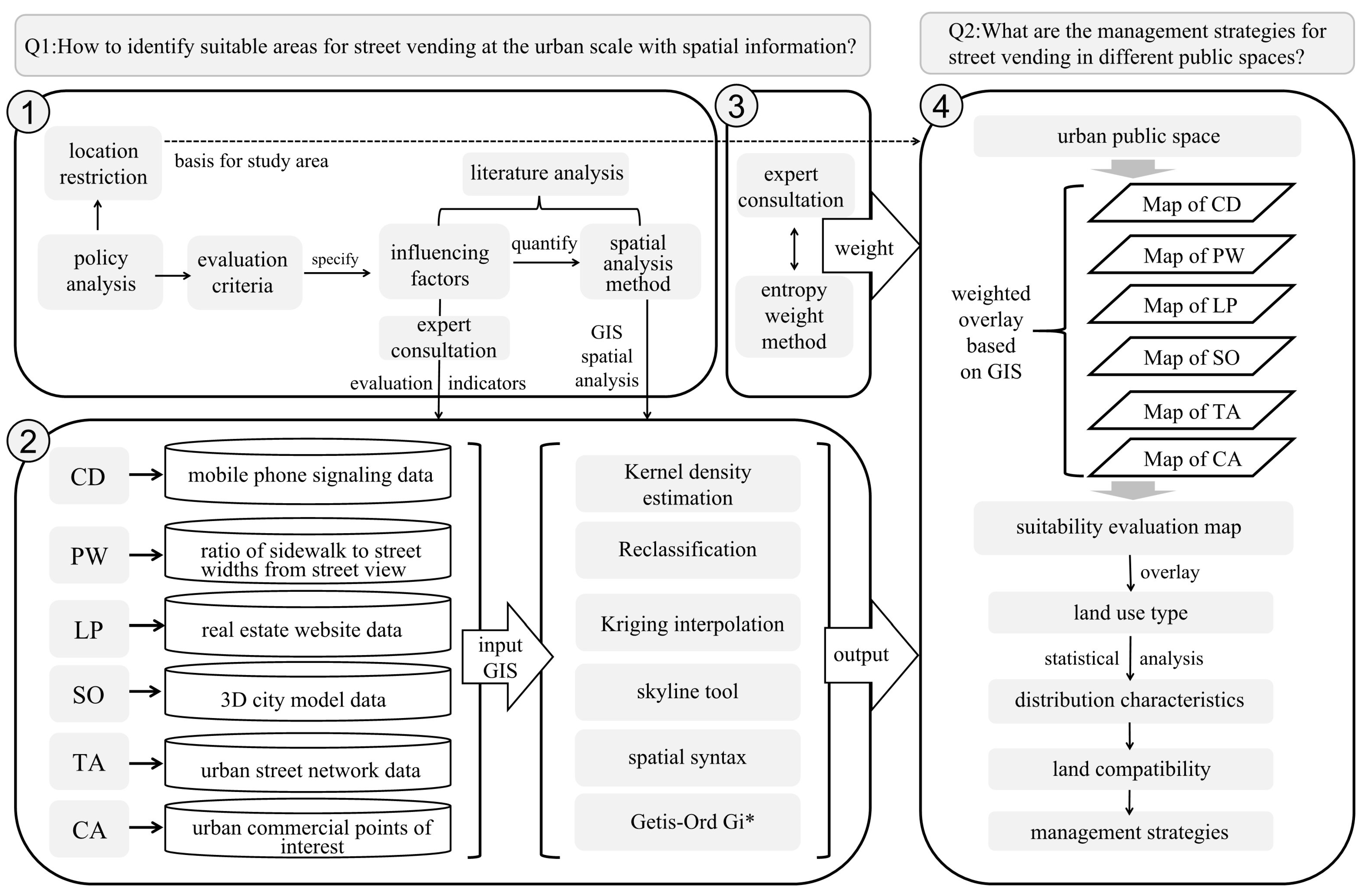
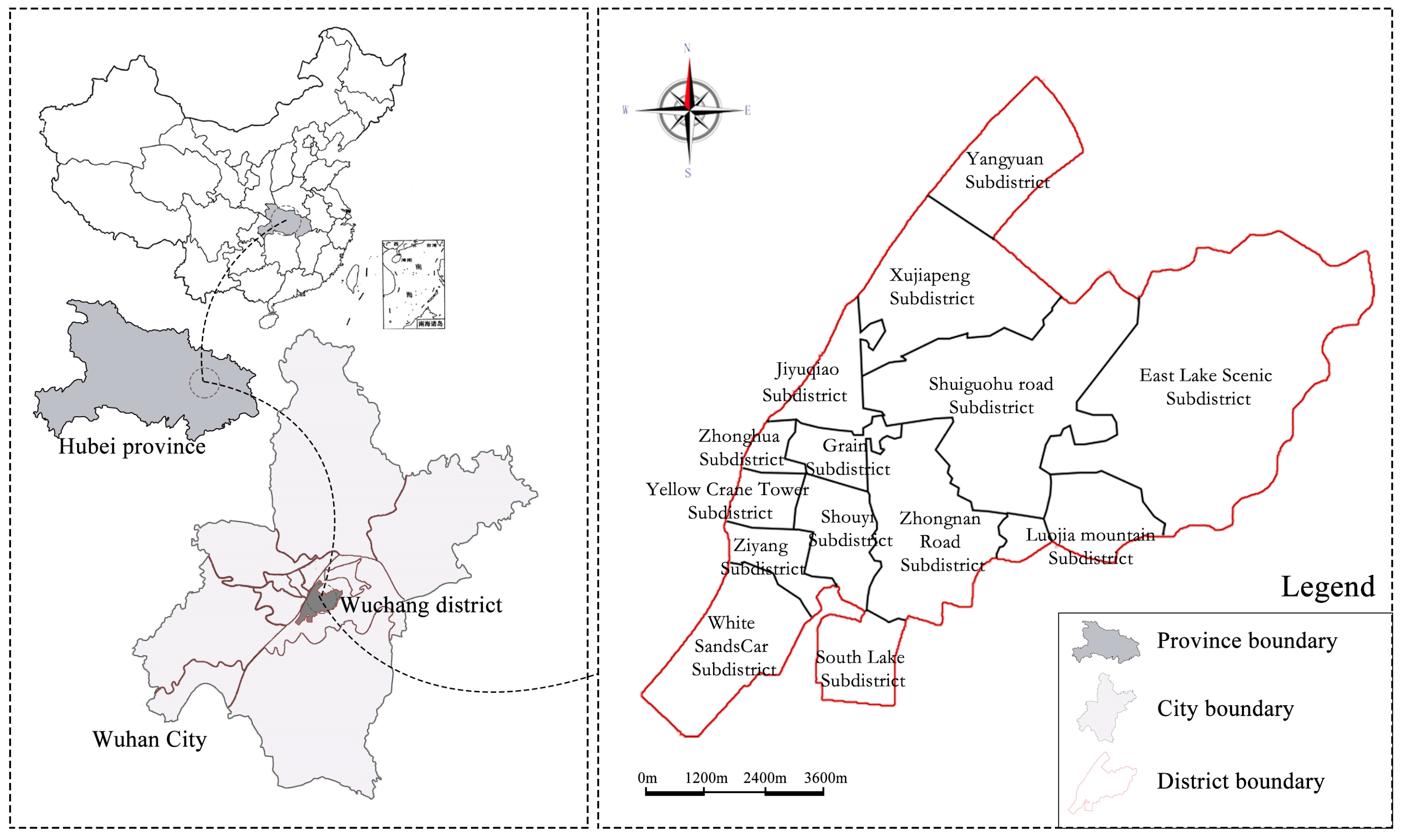
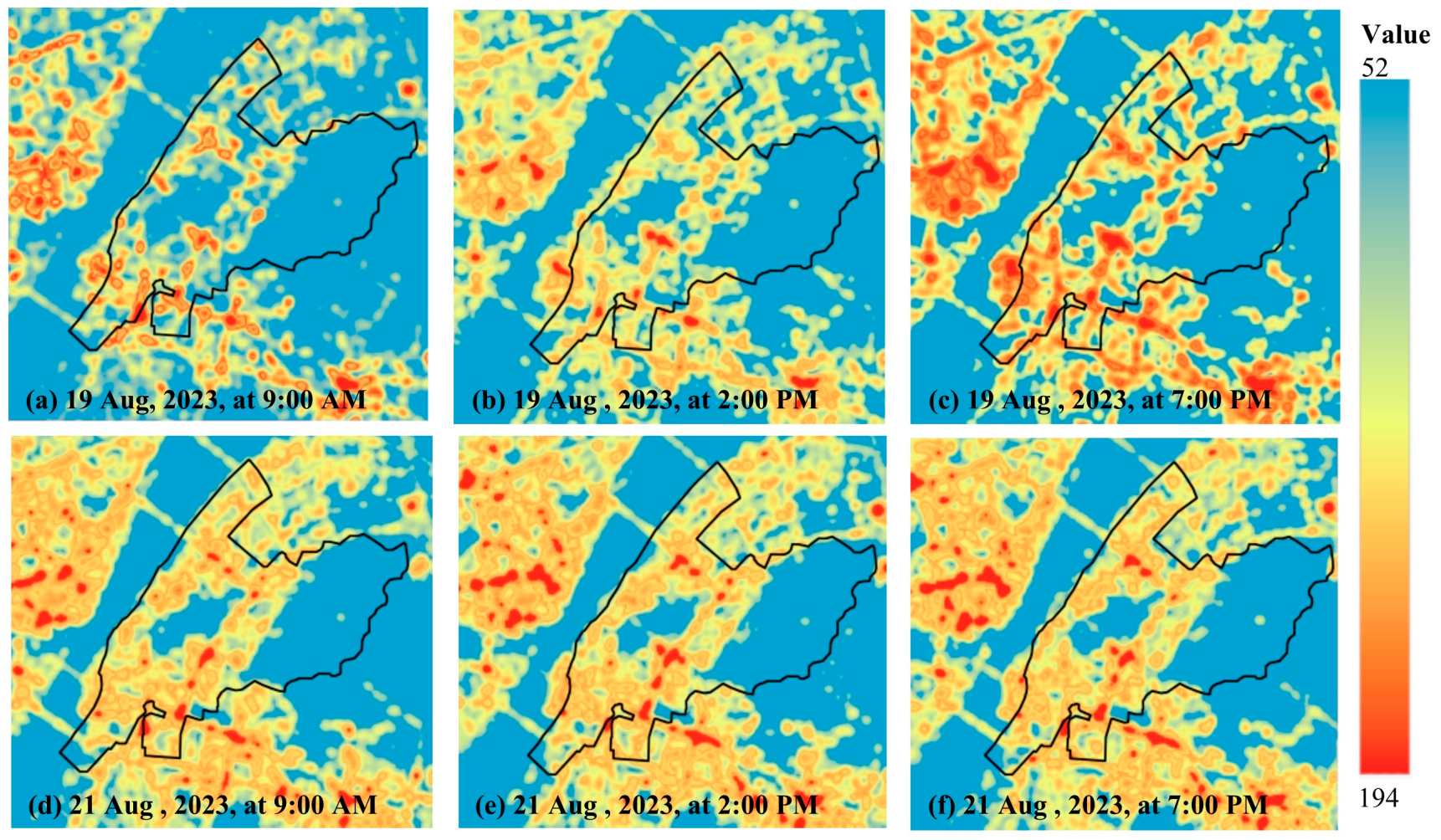


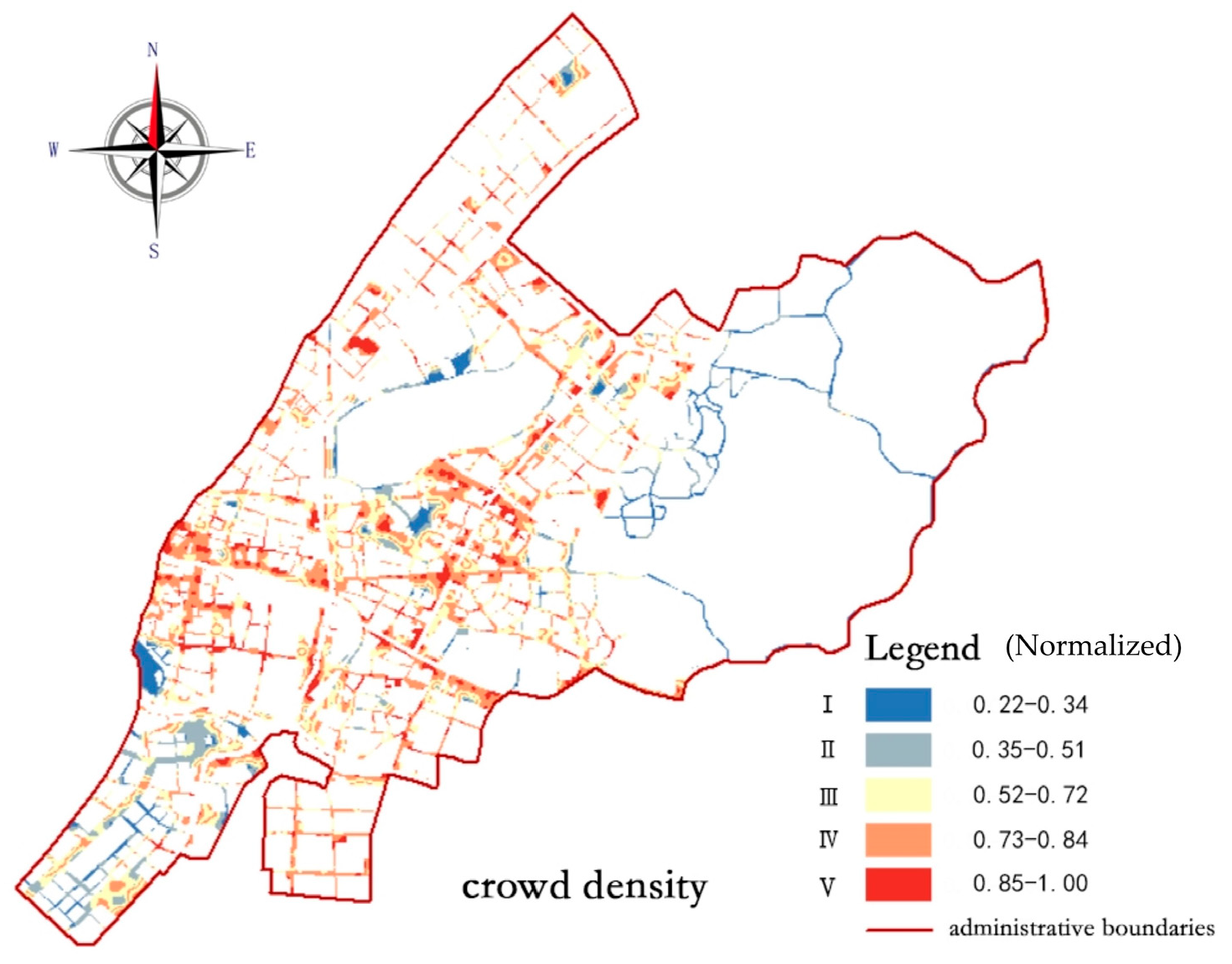




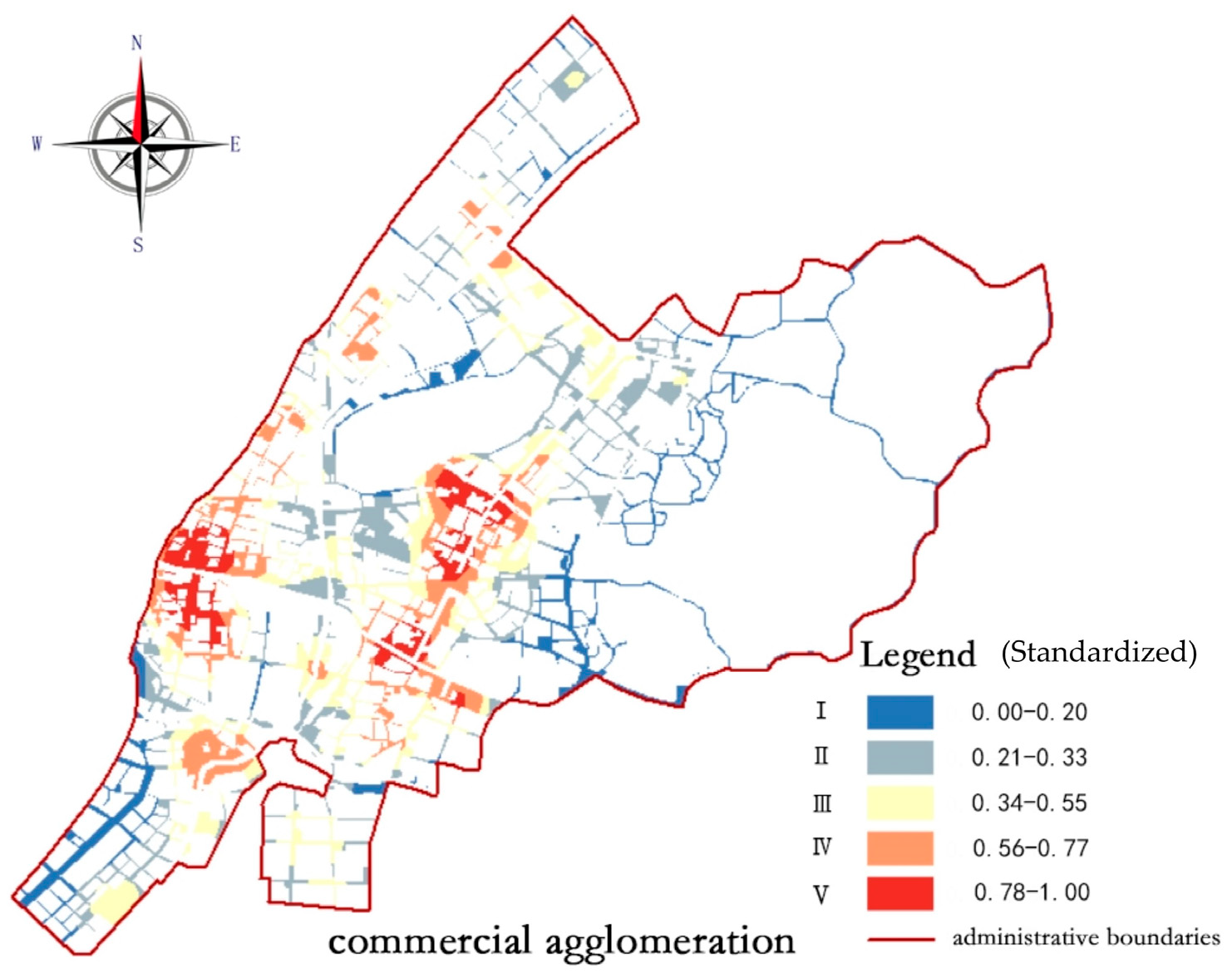
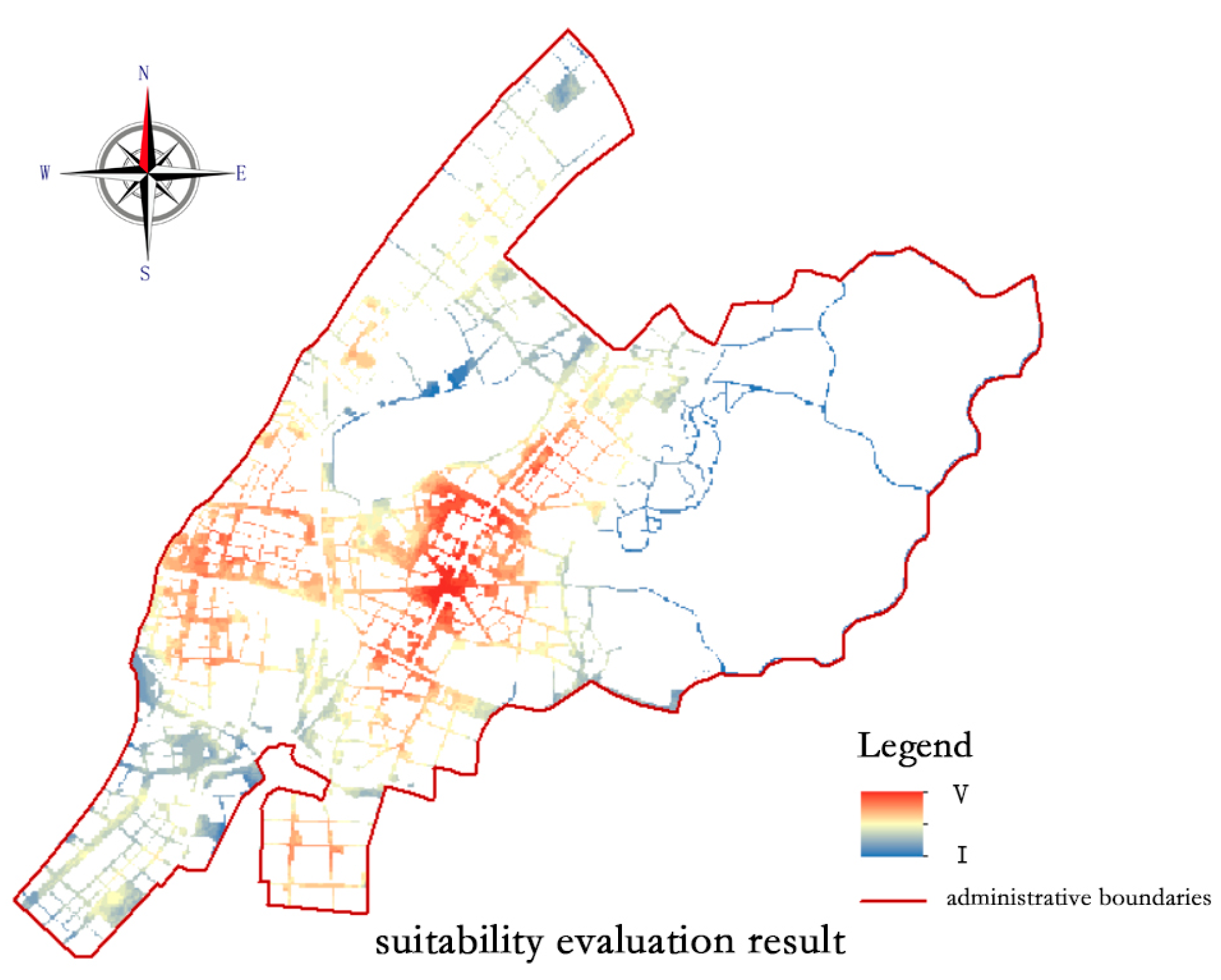
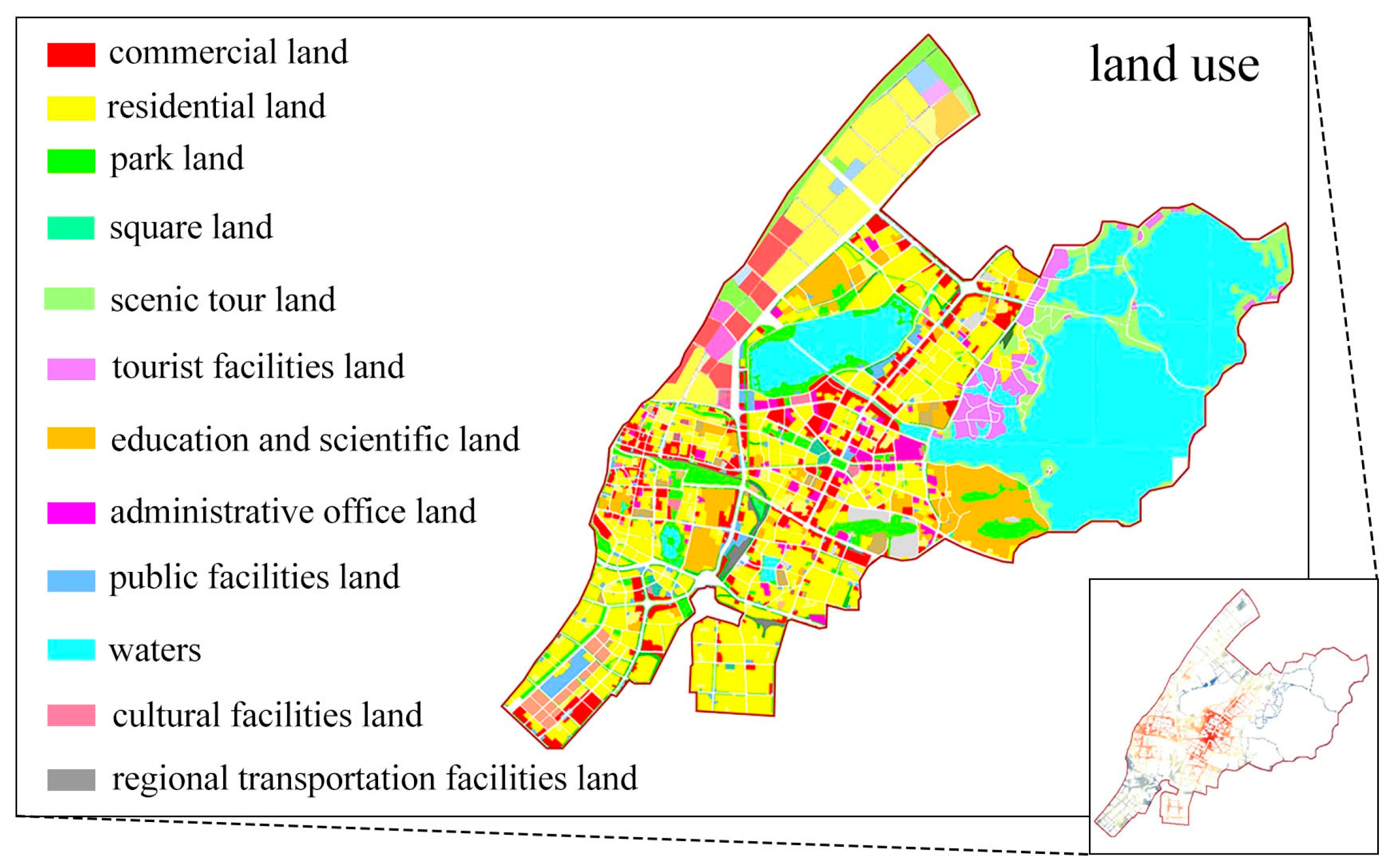

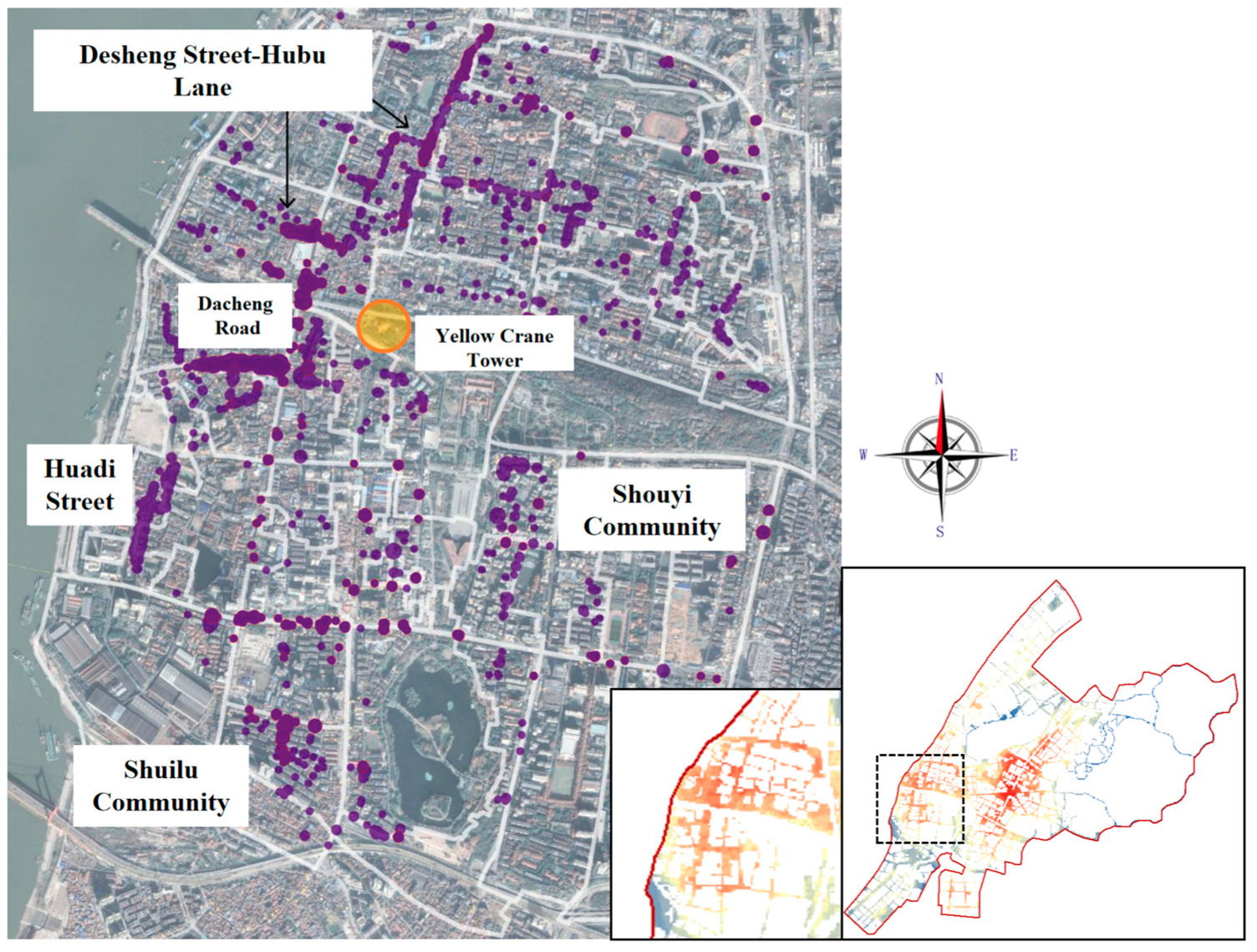
| Environmental Quality | Economic Dynamism | Social Participation | Infrastructure |
|---|---|---|---|
| Greening rate | Visibility | Land price | Pavement walkability |
| Commercial agglomeration | Crowd density | Traffic accessibility | |
| Air quality | Diversity of business types | Local popularity | Street lighting |
| Spatial openness | Consumer demand | Local publicity | Sanitation facilities |
| Item | Usage | Source |
|---|---|---|
| Street view image | Measure the width of the walkway | Google Maps |
| Administrative boundaries | Determine the administrative boundaries of Wuchang District | Open Street Map |
| Streets, road networks | Analyze transportation accessibility | Geofabrik China map data |
| Building data | Used for 3D city model construction | Geofabrik China map data |
| Mobile phone signaling data | Analyze population distribution characteristics in Wuchang District | Gaode map |
| WuHan OneMap Of Urban Planning | Identify land-use types in Wuchang District | Wuhan Municipal Bureau of Natural Resources and Planning |
| Commercial facility POI data | Analyze commercial agglomeration | Baidu Maps |
| Real estate website data | Analyze land price | Anjuke website |
| Indicators | Classification | Weight | ||||
|---|---|---|---|---|---|---|
| Ⅰ | Ⅱ | Ⅲ | Ⅳ | Ⅴ | ||
| CD (Normalized) | 0.22–0.34 | 0.35–0.51 | 0.52–0.72 | 0.73–0.84 | 0.85–1.00 | 0.068 |
| PW (Ratio) | 0.00–0.15 | 0.16–0.30 | 0.31–0.55 | 0.56–0.78 | 0.79–1.00 | 0.409 |
| LP (RMB/m²) | 27,737–44,441 | 23,319–27,737 | 20,006–23,319 | 17,107–20,006 | 9238–17,107 | 0.158 |
| SO (Ratio) | 0.93–1.00 | 0.82–0.92 | 0.74–0.81 | 0.62–0.73 | 0.45–0.61 | 0.090 |
| TA (Dimensionless) | 0.44–0.56 | 0.57–0.71 | 0.72–0.89 | 0.90–1.06 | 1.07–1.32 | 0.115 |
| CA (Standardized) | 0.0–0.20 | 0.21–0.33 | 0.34–0.55 | 0.56–0.77 | 0.78–1.00 | 0.160 |
Disclaimer/Publisher’s Note: The statements, opinions and data contained in all publications are solely those of the individual author(s) and contributor(s) and not of MDPI and/or the editor(s). MDPI and/or the editor(s) disclaim responsibility for any injury to people or property resulting from any ideas, methods, instructions or products referred to in the content. |
© 2024 by the authors. Licensee MDPI, Basel, Switzerland. This article is an open access article distributed under the terms and conditions of the Creative Commons Attribution (CC BY) license (https://creativecommons.org/licenses/by/4.0/).
Share and Cite
Zhang, X.; Shao, J. Evaluation of the Suitability of Street Vending Planning in Urban Public Space in the Post-COVID-19 Era. Land 2024, 13, 489. https://doi.org/10.3390/land13040489
Zhang X, Shao J. Evaluation of the Suitability of Street Vending Planning in Urban Public Space in the Post-COVID-19 Era. Land. 2024; 13(4):489. https://doi.org/10.3390/land13040489
Chicago/Turabian StyleZhang, Xiaosi, and Jizhong Shao. 2024. "Evaluation of the Suitability of Street Vending Planning in Urban Public Space in the Post-COVID-19 Era" Land 13, no. 4: 489. https://doi.org/10.3390/land13040489
APA StyleZhang, X., & Shao, J. (2024). Evaluation of the Suitability of Street Vending Planning in Urban Public Space in the Post-COVID-19 Era. Land, 13(4), 489. https://doi.org/10.3390/land13040489









